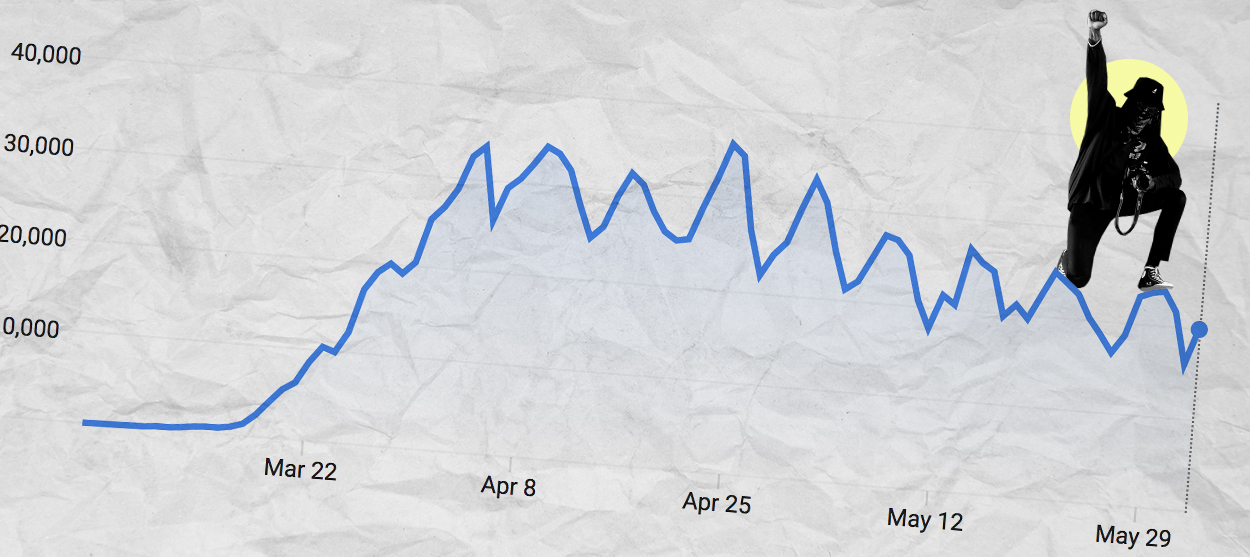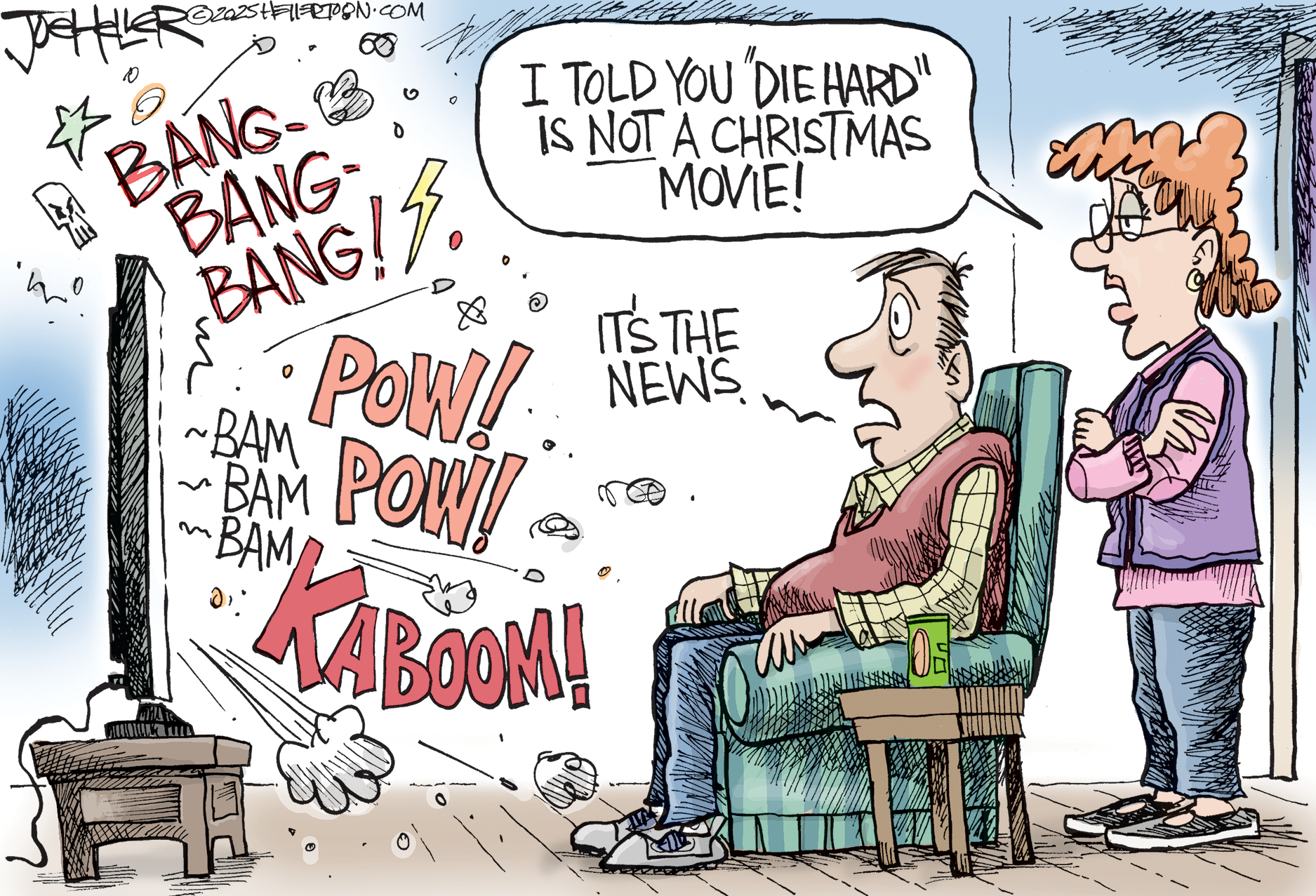The protests are putting key COVID-19 questions to the test
Coronavirus seemed to be on a post-lockdown decline. Then the protests started.


It is unreasonable to ask why protesters of police brutality may crowd into the streets of Manhattan while nearly all in-person religious services remain prohibited to contain the spread of COVID-19, New York City Mayor Bill de Blasio (D) informed a reporter for the ultra-Orthodox Jewish outlet Hamodia on Tuesday. "When you see ... an entire nation, simultaneously grappling with an extraordinary crisis seated in 400 years of American racism, I'm sorry, that is not the same question as ... the devout religious person who wants to go back to services," he said.
De Blasio is right it's not precisely the same question, but there are a lot of fair questions to ask here: If some activities not essential for immediate physical survival are worth the risk of coronavirus infection, why aren't others? Why is protest permissible when worship is not? What if your congregation holds a service at a protest? Is that allowed? Are our public health measures in this pandemic dictated by science — or politics? And, most practically: Will the protests produce a second wave of infections?
Whether we should be bracing for a pandemic resurgence post-lockdown was a pressing question before the George Floyd protests and subsequent rioting began. On a national scale, the new infection rate was slowly falling, but infectious disease experts like Dr. Anthony Fauci cautioned that ending the lockdowns might undo that progress. "There is no doubt, even under the best of circumstances: When you pull back on mitigation, you will see some cases appear," Fauci said in Senate testimony last month. "[T]here is a real risk that you will trigger an outbreak that you may not be able to control, which in fact, paradoxically, will set you back" on the road to normalcy.
The Week
Escape your echo chamber. Get the facts behind the news, plus analysis from multiple perspectives.

Sign up for The Week's Free Newsletters
From our morning news briefing to a weekly Good News Newsletter, get the best of The Week delivered directly to your inbox.
From our morning news briefing to a weekly Good News Newsletter, get the best of The Week delivered directly to your inbox.
If that was possible before there were mass gatherings all over the country (complete with tear gas, which makes the respiratory system more vulnerable), it is even more possible now. We already considered the risk of protesting during the pandemic when far smaller, fewer demonstrations were organized against the lockdown measures themselves. Though more sympathetic to the lockdown protesters than many, I echoed the common warning that such gatherings could become superspreader events. The justice of any protest's cause is irrelevant to the virus.
But the curious thing is Fauci's warning has yet to be vindicated as U.S. states and countries in Asia and Europe begin to re-open their economies. To be clear: We're not in a position to make a final call here, especially not in the United States, where many re-openings are still too new to definitely identify a post-lockdown spike in infections or a lack thereof.
Other nations, however, are further along. Some, like Lebanon and, at a very small scale compared to the initial spread, South Korea, have seen a second wave. Yet many others have not. "The lack of a resurgence in #COVID19 cases following the easing of lockdowns in several countries is intriguing," tweeted University College London professor Francois Balloux, whose research concerns genomics and epidemiology: How infectious disease outbreaks function and which pathogens "succeed." Balloux selected Switzerland as his example (though plenty of other places, including hard-hit Italy, show a similar preliminary pattern of post-lockdown decline). Switzerland's "lockdown ended on May 11 (schools/restaurants opened)," he noted. "Yet this did not translate in any increase in new cases so far."
Balloux suggested three possible (and possibly overlapping) answers. First, that some degree of "residual social distancing" is still preventing COVID-19's spread. This resonates with the argument made by Lyman Stone, the health data analyst I interviewed in April about why lockdowns may not be the best option for a robust and effective public health response. It also fits with some recent U.S. poll data suggesting most Americans are (or were, pre-police protests) still being more cautious than usual even as lockdowns end and their movement increases. There's reason to believe rising mask usage is making a difference, too: A study published in The Lancet on Monday used data from 16 nations to show a dramatic drop in COVID-19 transmissibility when masks are worn.
A free daily email with the biggest news stories of the day – and the best features from TheWeek.com
Second, Balloux continued, is the much-debated subject of seasonality: Other coronaviruses follow predictable seasonal patterns, with infections increasing when it's cold and dry and decreasing when it's warm and humid. Maybe summer is giving us a respite more than anything we're doing or neglecting. The George Floyd protests will function as an enormous natural experiment here: If there is no protest-linked resurgence, that alone may reasonably establish seasonality (though the rising caseload in hot, humid India isn't encouraging). The severe outbreak in Brazil — which now has the second-highest caseload worldwide as the Southern Hemisphere moves into winter — may also help to bring clarity.
Balloux's third idea was cross-immunization: "A proportion of the population might have pre-existing immunity to #SARSCoV2, potentially due to prior exposure to 'common cold' coronaviruses." If that were true, it could explain why there might be an appearance of herd immunity even as antibody testing for this specific virus returns fairly few positives. Similarly focused on the viral threat itself is the recent suggestion of two Italian doctors that the virus has mutated to a less potent form, though that proposal was dismissed by many epidemiologists. The protests may unintentionally provide a wealth of data with which to assess theories like these, too.
Whatever happens in the next two to five weeks, whether there is a second wave or not, two bad outcomes seem likely. First, the political and cultural divide between religious and non-religious Americans will be widened. De Blasio isn't the only official or public health expert to acknowledge increased risk of COVID-19 transmission because of the protests — which means more deaths — and yet still approve of them on political grounds. That's a defensible position, but when no similar exception is granted for sincerely held religious beliefs and practices, religious people will notice, and many will not be impressed by the distinction de Blasio and his crowd wish to make.
I say this as someone who supported voluntarily suspending our in-person church services, including on Easter, while coronavirus was rapidly spreading and the risk and nature of the illness was uncertain. It is one thing to say religious gatherings don't deserve special rights in public health emergencies. It is another entirely to say they don't get equal rights when other constitutionally-protected assemblies of great personal and social importance are permitted.
Second, the pandemic data the protests generate will be very valuable. It will also be incessantly disputed and may not meaningfully settle any of our pandemic debates, particularly the debates in which participants, frankly, do not seem terribly interested in mutual resolution. Confusing, contradictory, and misleading information has been a constant feature of this crisis, and the data wars show no sign of conclusion.
The messiness of re-opening data from Texas is a good case study. As The Atlantic's Derek Thompson summarized on Twitter mid-May: "Cases are way up. But tests are way, way up. And positivity rate is down. Oh, but the testing denominator might be jacked. And the death counts are spiky as hell." Whatever story you want to tell, whatever political point you want to score, data like that lets you do it.
We will find the same flexibility in the information we gather in June and July. The temptation on all sides to parse it to reflect a predetermined narrative will be enormous, and many will succumb.
Bonnie Kristian was a deputy editor and acting editor-in-chief of TheWeek.com. She is a columnist at Christianity Today and author of Untrustworthy: The Knowledge Crisis Breaking Our Brains, Polluting Our Politics, and Corrupting Christian Community (forthcoming 2022) and A Flexible Faith: Rethinking What It Means to Follow Jesus Today (2018). Her writing has also appeared at Time Magazine, CNN, USA Today, Newsweek, the Los Angeles Times, and The American Conservative, among other outlets.
-
 Political cartoons for December 21
Political cartoons for December 21Cartoons Sunday’s political cartoons include Christmas movies, AI sermons, and more
-
 A luxury walking tour in Western Australia
A luxury walking tour in Western AustraliaThe Week Recommends Walk through an ‘ancient forest’ and listen to the ‘gentle hushing’ of the upper canopy
-
 What Nick Fuentes and the Groypers want
What Nick Fuentes and the Groypers wantThe Explainer White supremacism has a new face in the US: a clean-cut 27-year-old with a vast social media following
